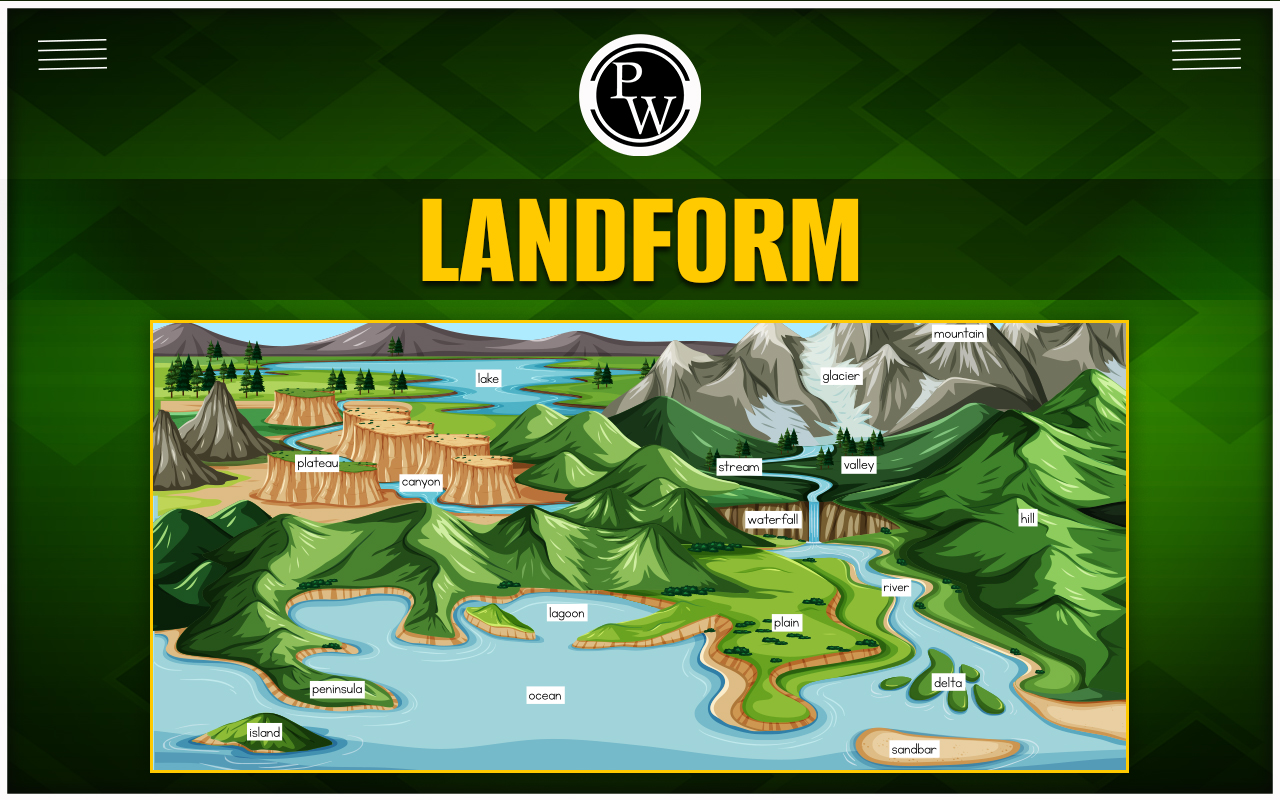

Landforms
Landforms are natural features of the Earth's surface, created by various geological processes over time. They shape the landscape and are an essential aspect of geography, influencing ecosystems, human activities, and weather patterns. Understanding landforms helps us comprehend the Earth's history and the forces that continue to shape it.Types of Landforms
Landforms can be broadly categorized based on their formation processes and features. Here are some primary types:Mountains
Mountains are large landforms that rise prominently above their surroundings, usually formed through tectonic forces or volcanic activity. They are characterized by steep slopes, high peaks, and significant elevation changes. Examples include the Himalayas, the Rocky Mountains, and the Alps.Formation of Mountains
- Tectonic Activity: Most mountains are formed by the movement of tectonic plates. When two plates collide, the land is pushed upwards, creating mountain ranges.
- Volcanic Activity: Some mountains, like the Hawaiian Islands, are formed by volcanic activity. Molten rock from beneath the Earth's surface erupts and cools, building up over time to form mountains.
Plateaus
Plateaus are flat, elevated areas that rise sharply above the surrounding terrain. They can be formed by volcanic activity, the uplift of tectonic plates, or the erosion of surrounding land.Types of Plateaus
- Intermontane Plateaus: Surrounded by mountains, such as the Tibetan Plateau.
- Piedmont Plateaus: Located at the base of mountains, like the Deccan Plateau in India.
- Continental Plateaus: Found within continents, like the Colorado Plateau in the USA.
Plains
Plains are broad, flat, or gently rolling areas, often found at low elevations. They are formed by the deposition of sediment over long periods, usually by rivers, wind, or glacial activity.Importance of Plains
- Agriculture: Plains are typically fertile and suitable for farming due to rich soil and flat terrain.
- Settlements: Many major cities and human settlements are located on plains due to the ease of building infrastructure.
Hills
Hills are elevated landforms that are smaller than mountains, often with rounded tops and gentle slopes. They can be formed by erosion or tectonic activity.Characteristics of Hills
- Less Steep: Hills are generally less steep and have a more gradual rise compared to mountains.
- Habitat: They often host diverse ecosystems and are used for agriculture and grazing.
Valleys
Valleys are low areas between hills or mountains, often with a river running through them. They are formed by the erosion of land by rivers or glaciers.Types of Valleys
- V-shaped Valleys: Created by river erosion, typically narrow with steep sides.
- U-shaped Valleys: Formed by glacial activity, broader and more rounded than V-shaped valleys.
Deserts
Deserts are arid regions with very little precipitation, characterized by extreme temperatures and sparse vegetation. They can be hot, like the Sahara, or cold, like Antarctica.Formation of Deserts
- Climate: Deserts are often formed in regions with high-pressure systems that prevent cloud formation and precipitation.
- Rain Shadow Effect: Mountains can block the passage of moist air, creating deserts on the leeward side.
Coastal Landforms
Coastal landforms are created by the interaction of the ocean and the land. They include beaches, cliffs, and deltas.Types of Coastal Landforms
- Beaches: Formed by the accumulation of sand and pebbles along the shoreline.
- Cliffs: Steep rock faces formed by the erosion of coastal rock by waves.
- Deltas: Formed at river mouths where sediment is deposited faster than it is removed by tides and waves.
Processes that Shape Landforms
Landforms are continuously shaped and reshaped by various geological and environmental processes.Erosion
Erosion is the process by which soil and rock are removed from the Earth's surface by wind, water, and ice. This process can create and alter landforms such as valleys, canyons, and coastal features.- Water Erosion: Rivers and streams can carve out valleys and canyons.
- Wind Erosion: Wind can erode rock and soil, creating features like sand dunes.
- Glacial Erosion: Glaciers can carve out U-shaped valleys and fjords.
Weathering
Weathering is the breaking down of rocks and minerals by physical, chemical, and biological processes.- Physical Weathering: The breaking of rocks into smaller pieces by temperature changes, frost, and root growth.
- Chemical Weathering: The decomposition of rocks through chemical reactions, such as oxidation or dissolution.
- Biological Weathering: The breakdown of rocks by living organisms, such as plant roots or lichen.
Deposition
Deposition is the process by which sediments are laid down in new locations. This can create landforms such as deltas, sand dunes, and alluvial plains.- River Deposition: Rivers carry sediments that are deposited when the water slows down, forming deltas and floodplains.
- Wind Deposition: Wind can transport sand and dust, forming dunes and loess plains.
- Glacial Deposition: Glaciers can deposit moraines and drumlins as they advance and retreat.
Tectonic Activity
The movement of the Earth's tectonic plates can create landforms through processes such as faulting, folding, and volcanic activity.- Faulting: When the Earth's crust cracks, blocks of land can move up or down, creating fault-block mountains and rift valleys.
- Folding: The bending of rock layers due to tectonic pressure can create folded mountains and valleys.
- Volcanic Activity: The eruption of magma can form volcanic mountains and islands.
Significance of Landforms
Landforms play a crucial role in shaping the natural environment and human activities.Ecosystems and Biodiversity
Different landforms provide unique habitats for various plant and animal species. Mountains, forests, rivers, and plains each support distinct ecosystems and contribute to biodiversity.Human Settlements
The location and development of human settlements are often influenced by landforms. Plains and river valleys are preferred for agriculture and urban development, while mountains and deserts are less hospitable but may have resources like minerals.Natural Resources
Landforms are rich in natural resources, including minerals, fossil fuels, and water. Mountains may contain valuable ores, plains may have fertile soils, and coastal areas can offer fishing and tourism opportunities.Climate and Weather
Landforms affect local and regional climates. Mountains can block or redirect air currents, influencing precipitation patterns. Coastal landforms can moderate temperatures and impact weather systems.Cultural and Recreational Significance
Landforms often hold cultural, historical, and recreational value. Mountains and rivers are frequently sites of cultural significance, while beaches and parks are popular for recreation and tourism. To succeed in upcoming exams, candidates should consider exploring PW SSC Books We provide high-quality content at an affordable price, including sample papers, mock tests, guidance sessions, and more to ensure aspirants secure their selection. Also, enroll today on SSC Online Coaching to turn your dreams into reality.Landforms FAQs
What is a landform?
A landform is a natural feature of the Earth's surface, such as mountains, valleys, plateaus, and plains, formed by various geological processe
How are mountains formed?
Mountains are primarily formed through tectonic forces or volcanism. The collision and movement of tectonic plates can push the Earth's crust upward, creating mountains.
What is the difference between a valley and a canyon?
A valley is a low area between hills or mountains, typically with a river running through it, while a canyon is a deep, narrow valley with steep sides, often carved by river erosion over a long period.
What are the characteristics of a plateau?
A plateau is a flat, elevated landform that rises sharply above the surrounding area on at least one side. It is characterized by its extensive flat top and relatively high elevation.
🔥 Trending Blogs
Talk to a counsellorHave doubts? Our support team will be happy to assist you!

Check out these Related Articles
Free Learning Resources
PW Books
Notes (Class 10-12)
PW Study Materials
Notes (Class 6-9)
Ncert Solutions
Govt Exams
Class 6th to 12th Online Courses
Govt Job Exams Courses
UPSC Coaching
Defence Exam Coaching
Gate Exam Coaching
Other Exams
Know about Physics Wallah
Physics Wallah is an Indian edtech platform that provides accessible & comprehensive learning experiences to students from Class 6th to postgraduate level. We also provide extensive NCERT solutions, sample paper, NEET, JEE Mains, BITSAT previous year papers & more such resources to students. Physics Wallah also caters to over 3.5 million registered students and over 78 lakh+ Youtube subscribers with 4.8 rating on its app.
We Stand Out because
We provide students with intensive courses with India’s qualified & experienced faculties & mentors. PW strives to make the learning experience comprehensive and accessible for students of all sections of society. We believe in empowering every single student who couldn't dream of a good career in engineering and medical field earlier.
Our Key Focus Areas
Physics Wallah's main focus is to make the learning experience as economical as possible for all students. With our affordable courses like Lakshya, Udaan and Arjuna and many others, we have been able to provide a platform for lakhs of aspirants. From providing Chemistry, Maths, Physics formula to giving e-books of eminent authors like RD Sharma, RS Aggarwal and Lakhmir Singh, PW focuses on every single student's need for preparation.
What Makes Us Different
Physics Wallah strives to develop a comprehensive pedagogical structure for students, where they get a state-of-the-art learning experience with study material and resources. Apart from catering students preparing for JEE Mains and NEET, PW also provides study material for each state board like Uttar Pradesh, Bihar, and others
Copyright © 2025 Physicswallah Limited All rights reserved.











